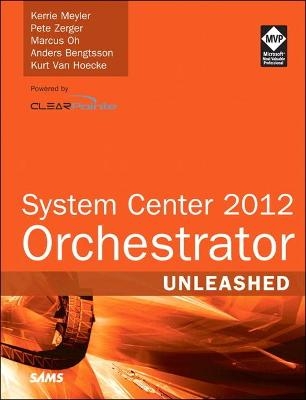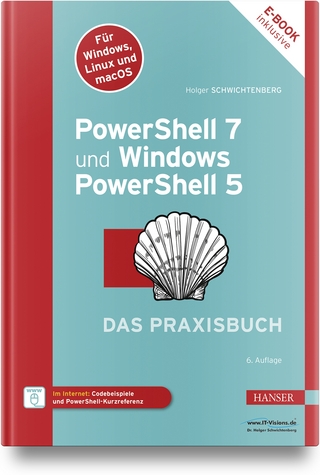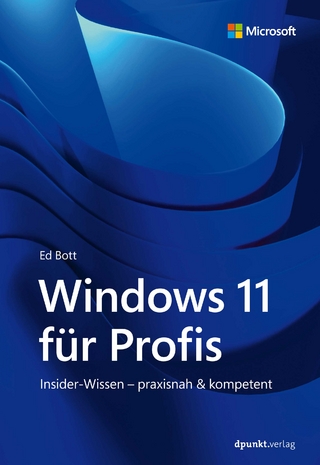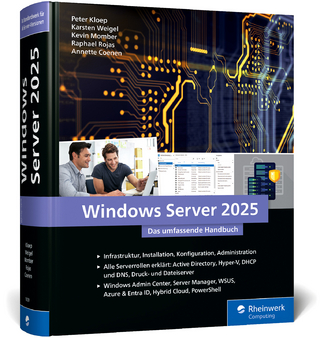
System Center 2012 Orchestrator Unleashed
Sams Publishing (Verlag)
978-0-672-33610-2 (ISBN)
Authored by five leading System Center experts, this comprehensive reference and technical guide brings together all the knowledge you’ll need to architect, install, implement, integrate, and maximize the value of your own Orchestrator solutions. The authors introduce current best practices based on large-scale enterprise implementations they’ve personally led or participated in.
This up-to-date guide shows how to apply Orchestrator’s major improvements to implement IT process automation in any environment, including private clouds. You’ll start with context: what Orchestrator does, how it has evolved, how it works, and essential architecture and design techniques. Next, the authors help you make crucial up-front decisions about activities, runbooks, security, and administration. Finally, you’ll find expert guidance for integrating Orchestrator with the rest of System Center and with Windows Azure cloud services—including advanced automated workflows that encompass both data center and cloud.
Detailed information on how to…
• Understand System Center 2012 Orchestrator’s capabilities, evolution, architecture, and design, including SP1 improvements and R2
• Successfully install System Center 2012 Orchestrator and migrate smoothly from Opalis Integration Server 6.3
• Take full advantage of Orchestrator’s advanced new runbook automation capabilities
• Configure activities associated with runbook control, systems, scheduling, monitoring, files, email, notification, and data handling
• Design runbooks for fault tolerance and optimal performance
• Enforce strong security using roles, permissions, and auditing
• Deliver integration capabilities for Operations Manager, Service Manager, Configuration Manager, Virtual Machine Manager, and Data Protection Manager
• Automate end-to-end data center/ cloud workflows with integration packs and PowerShell
• Create your own integration packs with Orchestrator Integration Toolkit (OIT.SDK)
• Support Orchestrator 2012, troubleshoot problems, and discover the best web and third-party resources
Kerrie Meyler, System Center MVP for Cloud and Datacenter Management, is the lead author of numerous System Center books in the Unleashed series. This includes System Center Operations Manager 2007 Unleashed (2008), System Center Configuration Manager 2007 Unleashed (2009), System Center Operations Manager 2007 R2 Unleashed (2010), System Center Opalis Integration Server 6.3 Unleashed (2011), System Center Service Manager 2010 Unleashed (2011), System Center 2012 Configuration Manager Unleashed (2012), and System Center 2012 Operations Manager Unleashed (2013). She is an independent consultant and trainer with more than 15 years of Information Technology experience. Kerrie has presented on System Center technologies at TechEd NA and MMS. Pete Zerger is a consultant, author, speaker, and System Center Cloud and Datacenter Management MVP focusing on System Center management, private cloud, and data center automation solutions. He is a frequent speaker at Microsoft conferences, and writes articles for a variety of technical magazines including Microsoft TechNet. Pete is a contributing author for several books, including System Center Opalis Integration Server 6.3 Unleashed (2011), PowerShell 2.0 Bible (Wiley, 2011), and System Center 2012 Operations Manager Unleashed (2013). He is also the co-founder of SystemCenterCentral.com, a popular web community providing information, news, and support for System Center technologies. In 2008, Pete founded the System Center Virtual User Group, a group dedicated to sharing System Center knowledge with users worldwide. Marcus Oh, System Center Cloud and Datacenter Management MVP, is a senior technical manager for a large telecommunications provider, running directory services and management infrastructure for ~30,000 systems. He has been an MVP since 2004 in System Center, specializing in Configuration Manager, Operations Manager, and Orchestrator. Marcus has written numerous articles for technology websites and blogs on Orchestrator and other System Center components at http://marcusoh.blogspot.com. He coauthored Professional SMS 2003, MOM 2005, and WSUS (Wrox, 2006), was a contributing author to System Center Opalis Integration Server 6.3 Unleashed (2011), and coauthored System Center 2012 Configuration Manager Unleashed (2012). Marcus is also the president of the Atlanta Systems Management User Group ( http://www.atlsmug.com ) and a board member of the Deskside Management Forum. Anders Bengtsson is a Microsoft senior premier field engineer focusing on System Center. He has written a number of System Center training courses, including the Service Manager 2010 and Operations Manager 2007 advanced courses for Microsoft Learning. He was a coauthor for System Center Service Manager 2010 Unleashed (2011). Before joining Microsoft, Anders was a Microsoft MVP from 2007-2010 for his work in the System Center community, including more than 10,000 posts in news groups and forums. Anders has presented and worked at numerous Microsoft conferences and events, including MMS and Microsoft TechEd NA and EMEA. Kurt Van Hoecke, System Center Cloud and Datacenter Management MVP, is a managing consultant at Inovativ Belgium. He focuses on the System Center product suite, including Orchestrator, Service Manager, and Configuration Manager. Kurt was a contributing author to System Center Service Manager 2010 Unleashed (2011) and blogs for System Center User Group Belgium and AuthoringFriday, where he shares his field experiences and discusses how to extend the built-in functionality of the System Center components.
Introduction 1
Disclaimers and Fine Print 3
PART I: ORCHESTRATOR OVERVIEW AND CONCEPTS
Chapter 1 Orchestration, Integration, and Automation 7
Orchestration, ITIL, and MOF 8
Integration, Automation, Orchestration The Differences 9
About Integration 10
Using Automation 11
About Orchestration 12
Benefits of Orchestration 13
How Orchestration Can Help 15
What Not to Expect with Orchestration 16
Positioning of Orchestrator in System Center 2012 16
Typical Use Cases 19
Regular Maintenance and Daily Operations 19
On-Demand Requests 20
Incident Management 20
IT Process Automation 21
Business-Oriented Processes Automation 21
Elastic Data Center 21
Managing a Project 22
Define Your Processes 22
Consistency Checking 23
Report on Operations 23
Technical Implementation 23
Example: Orchestrating a VM Deployment 23
Summary 27
Chapter 2 What’s New in System Center 2012 Orchestrator 29
The History of Orchestrator 30
The Beginnings of Orchestrator: OpalisRobot 30
OpalisRendezVous 30
Opalis Innovates 31
Goodbye Robot, Hello OIS 32
Microsoft’s Acquisition of Opalis Software 33
OIS to Orchestrator 34
OIS Migration to Orchestrator 35
Where Orchestrator Fits into System Center 35
OIS 6.3 Versus Orchestrator 2012 37
Terminology Changes 37
Services 40
Other Terminology Changes 41
Concept Changes 44
Architecture and Feature Changes 45
Prerequisite/Sizing Changes 45
Licensing Changes 47
Summary 47
Chapter 3 Looking Inside System Center 2012 Orchestrator 49
Architectural Overview 50
Server Components 52
Management Server 53
Runbook Server 54
Orchestrator Database 54
Web Service 54
Orchestration Console 54
Runbook Designer 55
Deployment Models 58
Minimum Installation Model 58
Additional Runbooks and Scaling Out 59
Multiple System Center 2012 Orchestrator Installations 59
Windows Services 63
Orchestrator Management Service (omanagement) 63
Orchestrator Remoting Service (oremoting) 63
Orchestrator Runbook Server Monitor (omonitor) 64
Orchestrator Runbook Service (orunbook) 65
Global Settings 65
Integration Packs 67
Runbooks 68
Data Bus 69
Connectors 71
Consoles 71
Using the Orchestration Console 72
Using Deployment Manager 72
Using Runbook Designer 72
Using Runbook Tester 73
Data Store Configuration 75
Community Tools 76
Communication 76
Summary 78
Chapter 4 Architectural Design 79
Planning and Implementing Orchestrator 79
Planning for Physical Design 83
Hardware Requirements 84
SQL Hardware Best Practices 88
Server Placement 90
Network Traffic and Protocols 90
Physical High Availability of Orchestrator Components 90
Scaling Out 92
Planning for Logical Design 92
Orchestrator Software Requirements 92
Runbook Design Standards and Best Practices 93
Service Accounts 96
Determining the Development Process and Security Model 97
Designing Logical Fault Tolerance 101
Summary 104
PART II: INSTALLATION AND IMPLEMENTATION
Chapter 5 Installing System Center 2012 Orchestrator 107
Orchestrator Installation Roadmap 107
Planning for Installation 108
Installing Orchestrator Features 110
Performing Post-Installation Tasks 111
Installing Orchestrator 112
Installing the Management Server 113
Installing the Runbook Server Using Installation Media 123
Installing the Runbook Server Using Deployment Manager 126
Installing the Web Service 128
Installing the Runbook Designer Using the Installer 131
Installing Runbook Designer Using Deployment Manager 134
Using the Command-Line Installation Tool 136
Performing Post-Installation Tasks 139
Registering and Deploying Integration Packs 139
Migrating Opalis Policies to Orchestrator 145
Summary 150
Chapter 6 Using System Center 2012 Orchestrator 151
Framework for Creating Runbooks 151
Analyzing the Desired Automation 152
Orchestrator Usage Scenarios 153
Analyzing Actions in the Automation 155
Translating Actions to Runbook Activities 159
Creating the Runbook in Orchestrator Runbook Designer 161
Configuring the Runbook Designer 161
Checking In and Checking Out 163
Configuring Runbook Properties 163
Using Activities and Links in Your Runbook 164
Data Manipulation When Configuring Activities 166
Using Published Data 168
Using Computer Groups with Runbooks 169
Using Regular Expressions 171
Using Counters 173
Using Schedules 174
Creating and Using Variables 176
Validating the Runbook 179
Managing Runbooks Using the Orchestration Console 181
Managing Runbooks with the Orchestrator Web Service 185
Web Service Resource Discovery 187
Using Visual Studio to Interact with the Web Service 188
Using PowerShell or VBScript to Interact with the Web Service 193
View Orchestrator Data by Using Excel PowerPivot 196
Summary 200
Chapter 7 Runbook Basics 201
Anatomy of a Runbook 202
General Information 202
Runbook Servers 203
Logging Properties 203
Event Notifications 203
Job Concurrency 204
Returned Data 205
Runbook Security 205
Using Activities 209
Activity Properties 210
Published Data 213
Orchestrator Standard Activities 214
System Activities 214
Scheduling Activities 214
Monitoring Activities 214
File-Management Activities 214
Email Activities 215
Notification Activities 215
Utilities Activities 215
Text File Management 215
Runbook Control 215
Monitoring Activities 215
Orchestrator Custom Activities 216
Orchestrator Workflow Control 216
Starting Point 216
Smart Links 218
Embedded Loops 220
Drag and Drop 220
Managing Runbooks 221
Starting and Stopping Runbooks 221
Importing and Exporting Runbooks 222
Versioning Runbooks 226
Auditing Changes 226
Runbook Logging 228
Real-Time and Historic Runbook Logs 228
Trace Logs 229
Audit Logs 231
Building Your First Runbook 232
Copying a File 232
Preserving Copied Files 233
Monitoring File Changes 234
Using Logic in Links 235
Summary 238
Chapter 8 Advanced Runbook Concepts 239
Advanced Schedules 239
Using the Monitor/Date Time Activity 240
Using the Check Schedule Activity 242
Invoking Child Runbooks 245
Looping Considerations 246
Behavior with Multiple Data Items 246
Configuring Looping Properties for an Activity 246
Preventing Infinite Loops 248
Monitoring for Conditions in Activities 249
Runbook Looping 251
Using Junctions 253
Synchronizing Branches 253
Republishing Data 253
Junction Examples 256
Working with Data 258
Data Manipulation Functions 258
Regular Expressions 260
Testing Functions and Regular Expressions 263
Error Handling 265
Overview of a Simple Runbook 265
Adding Error Handling 266
Computer Groups and Alternative Options 268
Entry Types 269
Using Computer Groups 269
Using Variables 270
Using NOW() As a Variable 271
Using Environment Variables 272
Using Encrypted Variables 272
Using Counters 272
Summary 273
Chapter 9 Standard Activities 275
Configuring Standard Activities 276
General Tab 276
Run Behavior Tab 276
Runbook Control Activities 277
Initialize Data Activity 277
Invoke Runbook 278
Return Data 280
Junction Activity 281
System Activities Category 282
Run .Net Script 283
Using Run Program 286
About Query WMI 289
Start/Stop Service 290
End Process 291
Restart System 292
Save Event Log 293
Run SSH Command 294
SNMP Activities 296
Scheduling Category 297
Monitor Date/Time Activity 297
Check Schedule 298
Monitoring Activities 298
File Management 300
Email Activities 302
Notification Activities 304
Send Event Log Message 305
Send Platform Event 306
Send Syslog Message 306
Utilities Category 307
Using Counters in Orchestrator 308
Data-Handling Activities 310
Other Utility Activities 315
Text File Management 316
Summary 317
Chapter 10 Runbook and Configuration Best Practices 319
Runbook Best Practices 319
Designing Runbooks for Fault Tolerance 326
Designing Parent and Child Runbooks 327
Using the Run Program Activity 331
Looping Within a Runbook 332
Configuration Best Practices 334
Specifying a Runbook Server and Runbook Throttling 334
Configuring SQL Server 335
Purging the Orchestrator Database 336
Useful SQL Queries 337
Verifying Runbook Design 339
Summary 348
Chapter 11 Security and Administration 349
Orchestrator Security Model 349
Running a Runbook Using a Specific Account 353
Auditing in Orchestrator 357
Changing Service Accounts 360
Database Roles 363
Exporting and Importing Runbooks 363
User Roles and Security 366
Connecting Remotely 369
Creating Runbook Folders 373
Assigning Permissions to Runbooks for Help Desk Operators 374
Summary 377
PART III: INTEGRATION PACKS AND THE OIT
Chapter 12 Orchestrator Integration Packs 381
An Integration Overview 382
Active Directory Integration Pack 382
Active Directory IP Typical Use Case 382
Active Directory IP Activity List 383
Active Directory IP Supported Versions 384
Active Directory IP Configuration Settings 385
Exchange Admin Integration Pack 386
Exchange Admin IP Typical Use Case 386
Exchange Admin IP Activity List 386
Exchange Admin IP Installation Notes 388
Exchange Admin IP Supported Versions 390
Exchange Admin IP Configuration Settings 390
Exchange User Integration Pack 391
Exchange User IP Typical Use Case 391
Exchange User IP Activity List 391
Exchange User IP Installation Notes 392
Exchange User IP Supported Versions 392
Exchange User IP Configuration Settings 392
FTP Integration Pack 394
FTP IP Typical Use Case 394
FTP IP Activity List 394
FTP IP Installation Notes 395
FTP IP Supported Versions 395
FTP IP Configuration Settings 395
HP Integration Packs 397
HP iLO and OA 397
HP Operations Manager 399
IBM Tivoli Netcool/OMNIbus Integration Pack 402
IBM Tivoli Netcool/OMNIbus IP Typical Use Case 402
IBM Tivoli Netcool/OMNIbus IP Activity List 402
IBM Tivoli Netcool/OMNIbus IP Installation Notes 403
IBM Tivoli Netcool/OMNIbus IP Supported Versions 403
IBM Tivoli Netcool/OMNIbus IP Configuration Settings 403
Representational State Transfer (REST) Integration Pack 404
REST IP Typical Use Cases 404
REST IP Activity List 405
REST IP Installation Notes 405
REST IP Supported Versions 405
REST IP Configuration Settings 405
HP Service Manager Integration Pack 406
HP Service Manager IP Typical Use Case 407
HP Service Manager IP Activity List 407
HP Service Manager IP Installation Notes 407
HP Service Manager IP Supported Versions 408
HP Service Manager IP Configuration Settings 408
VMware vSphere Integration Pack 409
VMware vSphere IP Typical Use Case 409
VMware vSphere IP Activity List 409
VMware vSphere IP Installation Notes 412
VMware vSphere IP Supported Versions 412
VMware vSphere IP Configuration Settings 412
Community-Developed Integration Packs 413
Orchestrator.codeplex.com 413
Scorch.codeplex.com 413
Summary 414
Chapter 13 Integration with System Center Operations Manager 415
Integration Pack Requirements 415
System Center 2012 Orchestrator 415
System Center 2012 Operations Manager 416
Installing the Integration Pack 416
Configuring the Integration Pack 416
Connectivity Requirements 416
Granting Access to the Connection Account 417
Configuring the Connection Account 417
Activities at a Glance 419
Activities in Depth 419
Use Case Scenarios 422
Incident Remediation 423
Server Maintenance Mode (Windows or *NIX) 424
Group Maintenance Mode 429
Creating a Runbook for Group Maintenance Mode in Operations Manager 2012 430
Branch Office Maintenance Mode 435
Processing Alerts in Bulk 438
Summary 443
Chapter 14 Integration with System Center Service Manager 445
Communication Requirements 445
Integration Pack Requirements 446
System Center 2012 Orchestrator 446
Locale Settings 446
Installing the Integration Pack 446
Configuring the Integration Pack 447
Activities at a Glance 448
Activities in Depth 449
Use Case Scenarios 450
Closing Resolved Incidents 451
Creating a Change Calendar 454
Automating Service Requests 457
Troubleshooting the SCSM IP 471
Summary 472
Chapter 15 Integration with System Center Configuration Manager 473
Integration Pack Requirements 473
System Center 2012 Orchestrator 473
System Center 2012 Configuration Manager 474
Installing the Integration Pack 474
Configuring the Integration Pack 474
Creating the Connection Account 474
Granting Access to the Connection Account 475
Connectivity Requirements 478
Activities at a Glance 479
Activities in Depth 480
Use Case Scenarios 482
Creating and Populating a Collection 482
Applying Endpoint Protection Policy 488
Applying Software Updates 492
Summary 505
Chapter 16 Integration with System Center Virtual Machine Manager 507
Integration Pack Requirements 507
System Center 2012 Orchestrator 508
System Center 2012 Virtual Machine Manager 508
Installing the Integration Pack 508
Configuring the Integration Pack 508
Connectivity Requirements 509
Security Credentials 509
Granting Access to the Connection Account 509
Configuring the Connection Account 509
Activities at a Glance 511
Activities in Depth 513
Advanced Deployment Capabilities in VMM 2012 518
Configuring Service Templates 520
The VMM Service Designer 521
Service Template Components 521
Additional Service Template Properties 522
Updating Running Service Instances 524
Use Case Scenarios 525
Enabling Self-Service 525
Virtual Machine Provisioning 535
VM Checkpoint and Recovery 540
VM Lifecycle Management 543
Working with Service Templates 551
Deploying a Service Instance (Service Template) 551
Scaling Out a Machine (Computer) Tier 553
Scaling In a Machine Tier 554
Performing In-Place Servicing 555
Summary 557
Chapter 17 Integration with System Center Data Protection Manager 559
Integration Pack Requirements 559
System Center 2012 Orchestrator 559
System Requirements 560
Installing the Integration Pack 560
Configuring the Integration Pack 560
Activities at a Glance 564
Activities in Depth 564
Use Case Scenarios 565
Creating a Recovery Point Before Installing Software 566
Preparing a Server for Patch Management 568
Restoring a SQL Server Database to a Network Folder 570
Troubleshooting the DPM IP 573
Summary 576
Chapter 18 Integration with Windows Azure 577
Integration Pack Requirements 578
Installing the Integration Pack 578
Quick Introduction to PFX Files 578
Configuring the Integration Pack 579
Activities at a Glance 582
Activity Categories in Depth 582
Use Case Scenarios 583
Deploying a New Virtual Machine in Windows Azure 584
Getting Information About a Virtual Machine in Windows Azure 588
Copying Files from a Local Folder to an Azure Storage Container 589
Deploying a New Web Service in Windows Azure 592
Summary 597
Chapter 19 Runbook Automation in the Data Center and the Cloud 599
Factors in Process Automation Planning and Design 599
The Role of Orchestrator in Cloud Computing 601
The Rise of the Hybrid Cloud 602
Use Case Scenarios 602
CMDB Automation (Dynamic Asset Management for Data Center and Cloud) 603
Cross-Platform Integration (Linux Service Restart) 609
Cloud Bursting (Capacity Management for Hybrid Cloud) 615
Summary 617
Chapter 20 The Orchestrator Integration Toolkit 619
Overview of the Orchestrator Integration Toolkit 620
Development Planning 620
Developing the Workflow Activities 622
Deploying Workflow Activities 622
Preparing the Project 623
Installing the Orchestrator Integration Toolkit 623
Installation Prerequisites 624
Toolkit Installation 624
Validating Toolkit Installation 626
Using the Command-Line Activity Wizard 627
Starting Assembly Creation 627
Creating a New Activity Assembly 628
Adding Activities to the Command-Line Activity Assembly 630
Testing and Validating the Assembly 635
Converting Opalis QIK CLI Assemblies 636
Using the Integration Pack Wizard 637
Creating a New Integration Pack 638
Updating and Converting Integration Packs 643
Using the Orchestrator SDK 644
Choosing a Development Approach 645
Start Building an SDK Activity Project 653
Creating a Custom Resource File 654
Declarative Approach 659
Using the Imperative Approach 663
Cascading Dependencies Approach 666
Summary 671
PART IV: APPENDIXES
Appendix A Community Solutions and Tools 675
Utilities and Scripts 675
Category Switcher 675
End User Portal for System Center Orchestrator 676
Orchestrator Health Checker 676
Orchestrator Remote Tools 676
Orchestrator Visio and Word Generator 676
Parse Orchestrator Export 677
Sanitize Export 677
SCO Job Runner 677
SCOrch Launcher 677
System Center Orchestrator Web Service PowerShell 678
Integration Packs 678
Working with Utilities 678
Working with System Center 680
Working with Other Microsoft Products 681
Appendix B Reference URLs 683
General Resources 683
Microsoft’s Orchestrator Resources 684
Additional Resources 686
Blogs 688
System Center 2012 Resources 689
Appendix C Available Online 691
PowerShell Scripts for the Operations Manager IP 691
PowerShell Scripts for the Virtual Machine Manager IP 691
Scripts for the Data Center Automation 692
Live Links 692
Index 693
| Erscheint lt. Verlag | 26.9.2013 |
|---|---|
| Reihe/Serie | Unleashed |
| Verlagsort | Indianapolis |
| Sprache | englisch |
| Maße | 180 x 230 mm |
| Gewicht | 1144 g |
| Themenwelt | Informatik ► Betriebssysteme / Server ► Windows |
| ISBN-10 | 0-672-33610-3 / 0672336103 |
| ISBN-13 | 978-0-672-33610-2 / 9780672336102 |
| Zustand | Neuware |
| Informationen gemäß Produktsicherheitsverordnung (GPSR) | |
| Haben Sie eine Frage zum Produkt? |
aus dem Bereich


